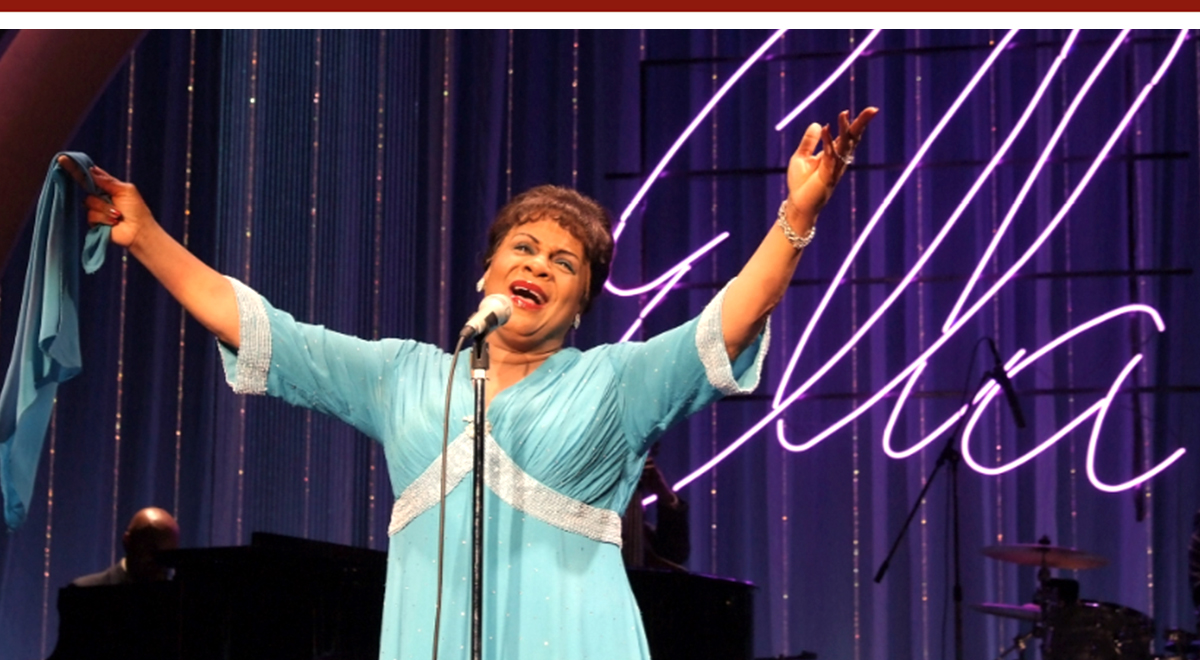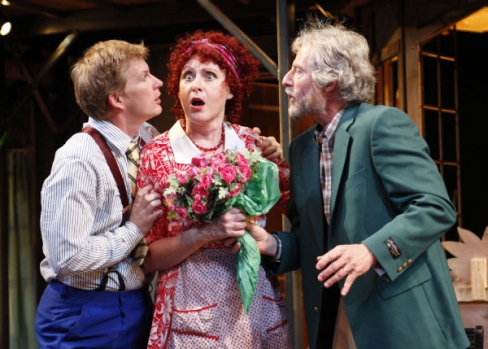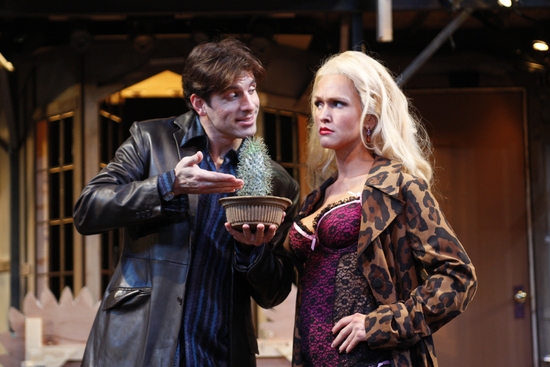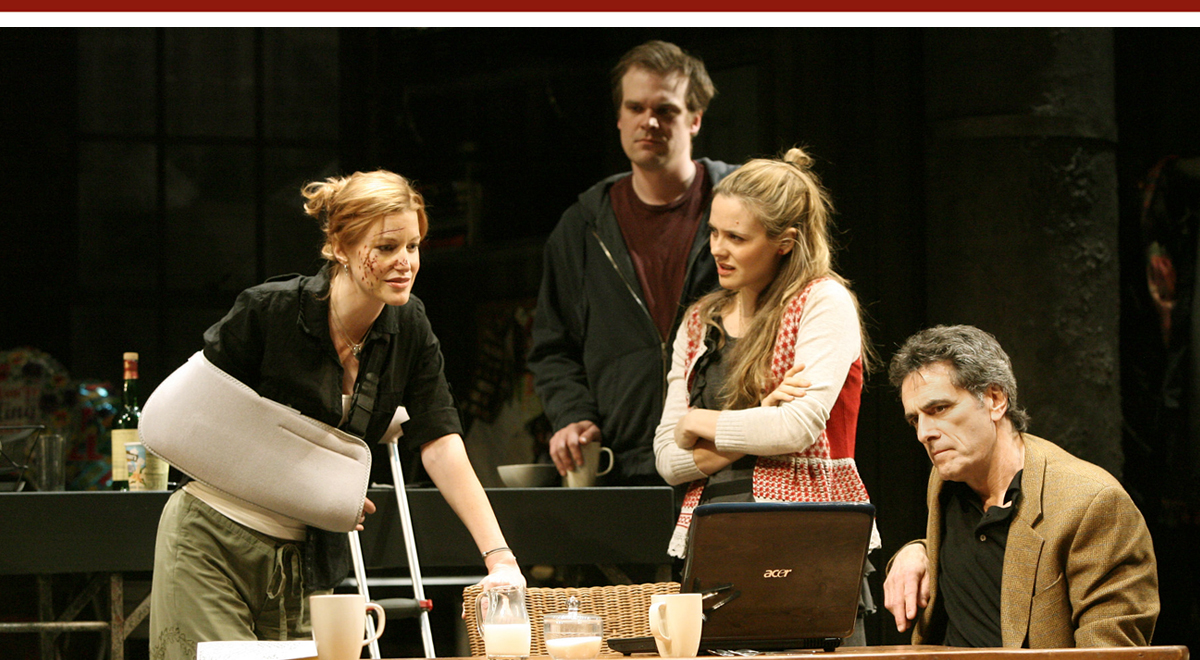FEBRUARY 2009
Click title to jump to review
ELLA by Jeffrey Hatcher | Laguna Playhouse
NOISES OFF by Michael Frayn | South Coast Repertory
TIME STANDS STILL by Donald Margulies | Geffen Playhouse

The feeling is mutualism
The bio-musical is spreading through Southern California theaters. Over the weekend, Ella took hold at the Laguna Playhouse (continuing through March 22). The healthy audience reaction indicates these shows will continue to grow stronger among host non-profits. They thrive in a time of airless theater budgets. Their powerful name recognition – here “First Lady of Song” Ella Fitzgerald – makes them virtually self-promoting, with catalogues of popular recordings that can attract crowds by airborne transmission or Pod.
In little more than a year the region has been exposed to the Pasadena Playhouse's Ray Charles Live and Stormy Weather (Lena Horne), The Jersey Boys (Four Seasons), The Rat Pack, and Mark Harelik’s Hank Williams: Lost Highway (also at Laguna). Then there are Herschel Felder's composer recreations of Gershwin, Chopin and Beethoven, which seem to spawn simultaneously in Westwood, Laguna and Balboa Park.
Part concert, part chronology, they are always fun, always fundable, and increasingly formulaic. Gone are the days when more work – and risk – were employed for songbook-based shows like Play On, the Sheldon Epps-Cheryl West concoction that used Duke Ellington’s music not to recount his life story, but to revisit Twelfth Night. The Education of Randy Newman (which, for disclosure this reviewer was publicist for) didn’t tell Newman’s story, but tried to get a handle on America’s story over the past half-century.
Without a strong book, the production is more of a concert booking. This play, now making its L.A./Orange County debut, was one of the earlier creations, introduced at the Hartford Stage in 2005 as Ella, Off the Record. A big success, co-conceivers Rob Ruggiero and Dyke Garrison wanted more out of Garrison’s book, and so on a commission from Florida Stage, respected playwright Jeffrey Hatcher took another look. He shed the subtitle and had Fitzgerald engage her audience from the beginning, which launched a wildly successful run that, according to Playbill.com, helped no less than nine regional theaters that year alone.
In Ella, Ella (Tina Fabrique, who has played Ella in most if not all the productions), her quartet, and her manager, record and concert producer Norman Grantz (Harold Dixon), are in a concert hall in Nice, France, for her 1966 performance. News of the death of Fitzgerald’s half-sister and soul mate Frances hangs over the first act rehearsals. Hatcher uses Fitzgerald’s building determination to override Grantz’s wishes and attend the funeral to represent Fitzgerald’s lifelong struggle for independence. We learn that her extraordinary talents had always been subjugated to man and manager through a lifetime of taunts about her looks. She attends her sister’s services back in the States during Intermission and Act II becomes the concert, with Ella in a familiar turquoise gown with the matching silk hand-scarf she waved when singing.
The musicians not only provide solid backup, they give voice to the men in Ella’s life. George Caldwell, pianist and conductor, also fills the role of Moe Gale, an early manager, among others. Trumpeter Thad Wilson impersonates Louis Armstrong for two songs including “Let’s Call the Whole Thing Off,” among other roles. Bassist Clifton Kellem – the only non-Equity cast member – is also bassist Ray Brown, who was married to Fitzgerald. And drummer Rodney Harper does a good job recreating Chick Webb, the short, and short-lived, drummer/bandleader who gave Ella her real launch, as well as layering on additional humiliation for her appearance. Webb, a tiny figure who suffered his own share of humiliation, would die of tuberculosis in his 30s, and forever hold a place in Fitzgerald’s heart as her “Buddy.”
The challenges for Hatcher and the others are, first to create a decent need for the subject to tell his or her story, and second, to try and place the obligatory songs so that they advance the story. If they can, they elevate the project from tribute concert to real musical. To get Fitzgerald to tell her story, Hatcher has her meet Grantz' request for between-song patter. In act one, she tests her recollections on the house. n act two, she reveals more than she had wanted. The problem with meeting the second goal is that, given the limited subject matter of the Great American Songbook (mostly happy or sad love songs), they don't form much of a narrative arc. Hatcher can only do so much. (Though, 'Miss Otis Regrets,' listed as previously in the show, would be a nice placed as a half-humorous threat to Grantz.) When he does make it work, as with “My Buddy,” the difference is significant and we are moved deeply.
For those who will never hear the real Ella in concert, the advisory should be given not to confuse her with mere singers and song stylists. Those who saw her benefit concert next door in the Laguna Bowl a couple decades back recall that even late in life she revealed a true artist touched with genius. That Fabrique gets us within earshot of that quality is testament to her talents. Something ineffable and magical in Fitzgerald's singing necessarily remains out of reach. That’s not to fault Fabrique, but to recognize the woman she embodies. Hopefully, audiences will carry that with them when this strain of bio-musical moves on.
top of page
ELLA
by JEFFREY HATCHER
musical supervision/arrangements by
DANNY HOLGATE
directed by ROB RUGGIERO
LAGUNA PLAYHOUSE
February 17-March 22, 2009
(Opened, rev’d 2/21)
CAST Tina Fabrique, George Caldwell, Harold Dixon, Rodney Harper, Clifton Kellem, Thad Wilson
PRODUCTION Michael Schweikardt, set; Alejo Vietti, costumes; John Lasiter, lights; Michael Miceli, sound; Charles LaPointe, wigs; Rebecca Michelle Green/Jennifer Ellen Butler, stage management; GeorgeCaldwell, musical direction
Tina Fabrique
Ed Krieger
Frayn nerve
Michael Frayn’s Noises Off has been topping off operating budgets at major and minor theaters since its British birth in 1982 and Broadway bow the following year. A quarter century later, South Coast Repertory has yielded to the lure of a play that many, many cite as the funniest ever written. Predictably, the audience pleaser has provided SCR its biggest catch of the season. Even so, one imagines the marketing cartoon of a woman holding her nose over a plate of sardines (the script’s running gag) inadvertently echoes a bit of nostril pinching needed over play selection.

Art Manke’s staging of Noises Off (through March 8) offers several worthy performances, including one especially good job, on its mad dash to nightly standing ovations and high-speed word of mouth. The three-act play follows a talent-challenged English theater company as it molests a British sex farce entitled Nothing On. Nothing On depends on nothing more than stock burlesque characters -- the beautiful dame who must spend the show in her lingerie; the man shuffling around in his dropped trousers, etc. -- and precision door-slamming to keep everyone from discovering what is really happening in the large house where they have assembled.
Noises Off depends on all that and the volatile backstage relationships that will eventually blow-up during a performance. In Act I, we see the “stumble-through” of a scene in Nothing On. In Act II we see a performance of it from backstage, as John Iacovelli’s set is spun around during first intermission. For Act III, we see it one last time, again from the audience perspective, as backstage and onstage calamities explode.

Put-upon director Lloyd Dallas (Kaleo Griffith) is in the house when the show starts. Unfortunately, when he first stands to help Dotty (Kandis Chappell) with blocking she can't grasp and remains motionless for several minutes – he is blocking those behind him. (We experienced it firsthand, wondering if a little wandering wouldn't have helped by spreading the obstruction around.) But Dotty's troubles are just the beginning as the rest of the cast repeatedly derail the rehearsal, to the constant distress of ASM Poppy (Winslow Corbett) and gofer Tim (Brian Hostenske). The company includes Garry (Bill Brochtrup, completely masking his affair with Dotty); Brooke (Jenn Lyon), a loose-lensed bit of cheesecake; Frederick Fellowes (Timothy Landfield), an apologetic actor always asking for clarification; Belinda (Nancy Bell), a dear, sweet and darling meddler who never addresses anyone without using dear, sweet or darling; and Selsdon Mowbray (Nick Ullett), a saucer constantly in his cups, playing hide and seek with an endless supply of whiskey bottles.
The Dotty-Director scene that opens the play, in which Chappell clearly goes back and forth between the dotty Dotty and the daffy character she’s playing, is the clearest we will see that separation between actor’s character and character's character. The rest of the show is really a blur of action without a lot of shaping. Manke lets the action rely on the basic comic parameters the script sets for itself. Farce and slapstick, despite their dependence on timing and physicality, still require moments to be set up in a way that play out with some surprise. (And yelling LOUDER does not qualify as surprising.) If the play establishes at the outset that plates of sardines will appear here and there unexpectedly, for example, their appearance ceases to be unexpected.
What feels missing is the reality against which all this insanity is to play. Frayn has woven some discreet relationships into the backstage comedy, yet they are not hinted at. When we discover them, they're not so much a surprise as unbelievable. More distinction between the Noises Off characters and those in the play-within-the-play would help us individuate the players, give us a foothold to have interest in their situations, and be somewhat distracted to let the eventual slapstick work.
The exceptions are Bell, an actress with great comedic instincts, who delivers an early throwaway remark about her love of technical rehearsals with the glee only the blissfully ignorant possess. It's a beautiful trait upon which to build, but doesn't feel properly taken advantage of by the director. Landfield is endearing and appealing.
The delight, however, is Lyon's Brooke. She has taken the stockiest of stock roles and given it a curious force of clueless determination. Employing poses she must have learned as a product model, Brooke’s blocking is simply trudging from mark to mark, then launching her limbs into display mode. Somehow, she manages to keep the gimmick fresh, and despite the monsoon of physical comedy around her, delivers the show's biggest laugh with a headfirst run in with a post. It just goes to show what a well-timed surprise can do.
Iacovelli’s set fits the play’s requirement for something that required extra build time, shortening the tech period and upping the anxiety. It seems a bit elaborate for a touring set, though. Angela Balogh Calin’s costumes are delightful and York Kennedy lights it all just right. Jamie Tucker and Chrissy Church, the stage management team that run the behind-the-scenes’ comedy’s real backstage, land their cues admirably.
top of page
NOISES OFF
by MICHAEL FRAYN
directed by ART MANKE
SOUTH COAST REPERTORY
February 6-March 8, 2009
(Opened 2/13, rev'd 2/21m)
CAST Kandis Chappell, Kaleo Griffith, Bill Brochtrup, Jenn Lyon, Winslow Corbett, Timothy Landfield, Nancy Bell, Brian Hostenske, Nick Ullett
PRODUCTIONJohn Iacovelli, set; Angela Balogh Calin,costumes; York Kennedy, lights; Vincent Olivieri, sound; David Nevell, dialect; Jamie A. Tucker/Chrissy Church, stage management
Bill Brochtrup, Kandis Chappell and Timothy Landfield, top; Kaleo Griffith and Jenn Lyon
Henry DiRocco
Freeze frame
New plays from America’s finest playwrights are cause to stop what we’re doing and take a close look. Following a thin moneymaker called Shipwrecked, about an adventurer stuck spinning a single yarn into theatrical gold, Donald Margulies has, in Time Stands Still (Geffen Playhouse through March 15), written a dense contemporary snapshot of how art, journalism and romance can be used to distance us from reality and each other.
In Time, Margulies has returned from the singular focus of his shipwreck survivor to the two-couple canvas he used to Pulitzer Prize-winning effect in Dinner With Friends (1998). Around them he burns in a background of well-positioned arguments about our responsibility for others’ welfare. He lets these weighty opinions balance out, intentionally depriving audiences of easy answers, dulling the usual moral compass points, and muting his own voice of judgment calls.
From rise, director Daniel Sullivan, who guided Dinner, from Costa Mesa to New York, and his fine cast spring-load John Lee Beatty’s single set with tension. Helping a broken Sarah (Anna Gunn) into her dark, contemporary Brooklyn loft is Jamie (David Harbour), her boyfriend of eight years. She is physically and emotionally scarred from a war zone bomb blast. Margulies carefully, elegantly ekes out his exposition, milking the mystery as he avoids headlining the backstory. We learn Sarah is a photojournalist and Jamie is a free-lance reporter. They have been filing copy and photos on Iraq war’s toll on local civilians. When her HumVee hit an IED, the explosion put her in a coma and killed the driver, Tarik, whom she had come to love as he served as her “fixer” (a term with photographic resonance).
The other couple is Richard (Robin Thomas) and Mandy (Alicia Silverstone, out at this performance and replaced by understudy Monica McCarthy). This is a relationship that begins where Dinner’s second-couple marriage ended, with husband Tom exiting for a younger woman who makes "all of my stories . . . new again."
Mandy is in event planning, an arm of marketing and promotion she insists is not public relations. She is an innocent, while Richard, three years younger than her dad, is a photo editor at the magazine that sent Sarah to the war zone, and buys stories from free-lance reporter Jamie.
Margulies signals his venture into inextricably tangled themes by leaving a signpost at the play’s entrance. The title salutes the ambitions of photojournalism and the arts in general to “capture the moment” and “bring the story back alive.” But, we learn through the characters’ debates, these can never be more than representations of reality, as much a means of avoidance as of understanding.
Where the script may need tinkering is in the number and weight of the many themes. The play was first called The Elephant in the Room. That title was clearly insufficient. There are many elephants in the room: guilt, love, lies, war, ambition, Tarik, motherhood, and responsibility for individual and national blunders. At times his dialogue lapses into unnatural speechifying that briefly bury his full-bodied characters under a crush of pontification. Also, it doesn’t work to use Mandy, who must be naive in order to make later epiphanies work, to prompt divulging Sarah’s and Jamie’s histories. With just a poke, this woman they have just met, and completely dismissed, gets them to break open like bags of groceries. This after Jamie further distances her by insisting she call him James while everyone else in the room uses the informal form of address. She may need to make some real (if misguided) assertions about things in order to get them that engaged. As it is, they just wouldn’t feed their stories to her (and us) at that point – for these reasons.
The playing is excellent. Anna Gunn is a remarkable actress who gets to show off her range. Unfortunately, she is still forced to make some big leaps to connect plot points that do not yet flow. Her abandonment of marriage, which she is not allowed to build to, can be justified by the audience, but not based on the actions as written. Harbour is fine for the most part, but there’s more sameness throughout than serves the play. His Jamie responds from the gut, and the play may want someone whose intellectual positioning – as in the case of his horror movie thesis – feels more grounded. His motivations are murky as it stands, which doesn’t help with those big leaps we’re now asked of Gunn’s Sarah.
In for Silverstone, McCarthy is comfortable in the role. Her big scenes are played effectively and if Silverstone is missed at all it might be for some defter handling of the comic possibilities in the early scenes. Like Tom before him, Richard is ultimately the least tortured character and Thomas services him well.
Some twists and juxtapositions don’t go smoothly, yet. But the current troubles result from the tectonic collisions of big-plate themes – or butting elephants – he wants shifting under his characters. Time Stands Still is as much about what happens on the domestic front as it is what happens on foreign soil. If he gives equal weight to the notions that events demand we take responsibility and that we are cleansed of responsibility by humanity’s insistence on greed and cruelty, he does call us to action. We must not accept representations of life as stand-ins for firsthand experience. Whether we’re discussing our interventions with other countries, or our intentions for other people, time never stands still.
top of page
TIME STANDS STILL
by DONALD MARGULIES
directed by DANIEL SULLIVAN
GEFFEN PLAYHOUSE
February 3-March 15, 2009
(Opened 2/11, rev’d 2/28m)
CAST Anna Gunn, David Harbour, Alicia Silverstone, Robin Thomas, u/s –Monica McCarthy (performing for Silverstone), Robert Shampain, Darin Singleton
PRODUCTION John Lee Beatty, set; Rita Ryack, costumes; Peter Kaczorowski, lights; Jon Gottlieb, sound; Peter Golub, music; James T. McDermott/JillGold, stage management
HISTORY World Premiere. Commissioned by Geffen Playhouse.


